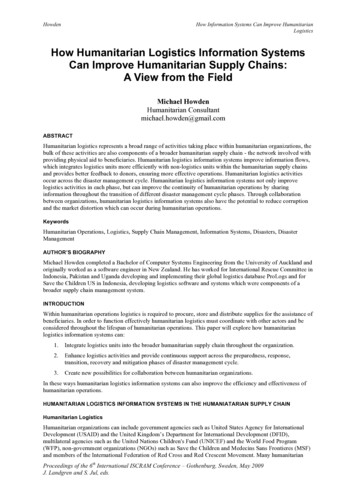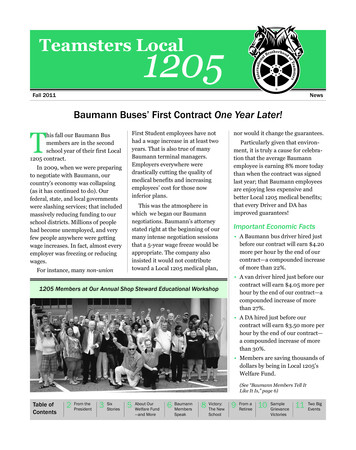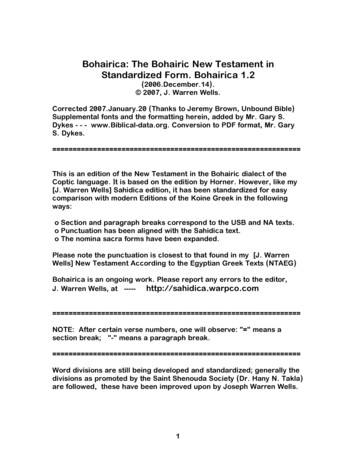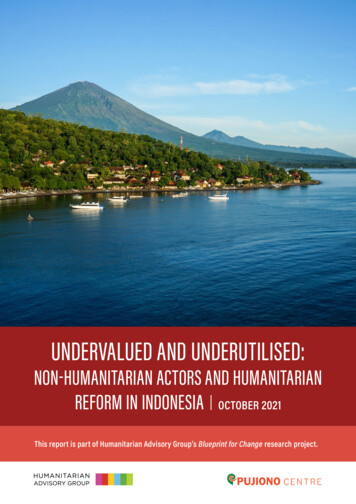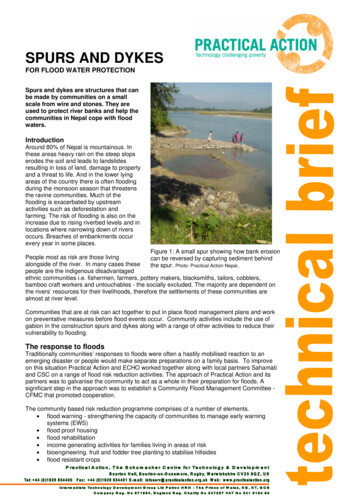
Transcription
SPURS AND DYKESFOR FLOOD WATER PROTECTIONSpurs and dykes are structures that canbe made by communities on a smallscale from wire and stones. They areused to protect river banks and help thecommunities in Nepal cope with floodwaters.IntroductionAround 80% of Nepal is mountainous. Inthese areas heavy rain on the steep slopserodes the soil and leads to landslidesresulting in loss of land, damage to propertyand a threat to life. And in the lower lyingareas of the country there is often floodingduring the monsoon season that threatensthe ravine communities. Much of theflooding is exacerbated by upstreamactivities such as deforestation andfarming. The risk of flooding is also on theincrease due to rising riverbed levels and inlocations where narrowing down of riversoccurs. Breaches of embankments occurevery year in some places.Figure 1: A small spur showing how bank erosionPeople most as risk are those livingcan be reversed by capturing sediment behindalongside of the river. In many cases thesethe spur. Photo: Practical Action Nepal.people are the indigenous disadvantagedethnic communities i.e. fishermen, farmers, pottery makers, blacksmiths, tailors, cobblers,bamboo craft workers and untouchables - the socially excluded. The majority are dependent onthe rivers’ resources for their livelihoods, therefore the settlements of these communities arealmost at river level.Communities that are at risk can act together to put in place flood management plans and workon preventative measures before flood events occur. Community activities include the use ofgabion in the construction spurs and dykes along with a range of other activities to reduce theirvulnerability to flooding.The response to floodsTraditionally communities’ responses to floods were often a hastily mobilised reaction to anemerging disaster or people would make separate preparations on a family basis. To improveon this situation Practical Action and ECHO worked together along with local partners Sahamatiand CSC on a range of flood risk reduction activities. The approach of Practical Action and itspartners was to galvanise the community to act as a whole in their preparation for floods. Asignificant step in the approach was to establish a Community Flood Management Committee CFMC that promoted cooperation.The community based risk reduction programme comprises of a number of elements. flood warning - strengthening the capacity of communities to manage early warningsystems (EWS) flood proof housing flood rehabilitation income generating activities for families living in areas of risk bioengineering. fruit and fodder tree planting to stabilise hillsides flood resistant crops
Spurs and dykes Practical Actionevacuationrelief distributionfood storageimmunisation of people and their animalsspray of insecticides after flood to prevent epidemic waterborne diseases like diarrhoea,dysentery, cholera, typhoid, pneumonia, etc.risk mapping – mapping out the flood areas and its effects on those areasstructural measures for diverting and checking flood water through the use of spurs anddykesIn Nepal, the community, through the CFMC, was able to ask for technical support from thevarious division or sub-division offices of the Department of Water Induced Disaster Prevention.These offices often also provide material support such as gabion boxes and sand bags. Thereare many other organisations that may provide technical as well as financial support to carry outthese works. Therefore the CFMC needs to be well informed of the options.The CFMC also coordinates activities during flooding. These include; filling the breaches of theembankment, deflecting river flow, isolating water wells. Preventing provision stores, healthcentres and other structures from being flooded may become an essential activity. Adequateprovision of materials for these tasks should be obtained and stored at convenient places.Structural OptionsVarious structural measures can be used depending on the particular requirements of an area.Material like loose stones, bricks, bamboo piles, bamboo mats, stone filled gabions, and sandfilled bags are all used. With appropriate support the community can do the bulk of the workincluding collecting stones, filling the gabions, and earthworks etc.Dykes run along the side of river ratherthan protruding into the river. Theyprotect the river bank from erosion butdo not redirect the river.Embankments are constructed alongthe river bank to raise the bank leveland stop the water spilling over. Theembankments are made of earth andare sometimes additionally protectedwith revetments.Revetments are structures placed onbanks in such a way as to absorb theFigure 2: Section through a gabion dyke. Illustration:energy within the moving waterPractical Action / Neil Nobletherefore protecting the land behindthem from erosion. In Nepal they are often porous and will allow water to filter through.Spurs are structures that protrude into the river. Small spurs know as studs help keep the floodwater away from venerable banks.Long spurs, also referred to as groynes, are used to direct the course of the river away from avulnerable bank. The spurs make permanent changes to the rivers course by capturingsediment. The spurs are often made of gabions as they have to be strong enough to resist theforce of the water during periods of flooding. This practice is known as river training.2
Spurs and dykesPractical ActionStraightFlowofriverSpurspositionedon riverbendBayonetT-HeadFigure 3: Spurs used for controlling erosion at bends in rivers and spur design options.Illustration: Practical Action / Neil NobleConstruction SpursFor spurs to be effectivethey have to be designedand built in such a way toensure that they can resistthe strongest forces fromfloodwater. This can bedone be using professionalexpertise in the initialphase of the project.These preliminary stagesencompass carrying out designwork for all structuresand producing detailedtechnical drawings assisting communitieswith quotation andpurchasing activitiesand ensuringstandards of inputsand materials supervising communityconstruction activitiesFigure 4: A newly constructed spur shown before the monsoon. The baseof the river and the spur apron are clearly visible in the dry season.Photo: Practical Action Nepal. liaising with localauthorities over standards and legal requirements carrying out community training where necessary verifying community expenditures and cost estimatesThe cost of creating the spurs and dykes can be kept low through community participation.3
Spurs and dykesPractical ActionIdeally land is contributed to the project and the labour contribution will vary from between 10and 100% depending on the type of activity and the need for specialist contributions. Often themajority of materials are also donated to the project.In the example of the spur constructed at Chitwan specialists were used in the design stage ofand engineering drawings produced from which the project requirements in terms of material andlabour could be determined. The spur construction is shown in Figure 5. The size and shape willFigure 4: Cross section of a spur design in Chitwan showing substantial groundworkIllustration: Practical Action Nepal.change depending on the particular circumstances of each location.An essential element to constructing a spur is the incorporation of the apron which ensures thatthe structure is not undermined by the current. The design should ensure that the spur is rootedinto the bed of the river and not resting on the river bed (as in the case in figure 4) where thestructure is likely be rolled away during heavy flooding.In general the communities in Nepalhave shown a great deal ofmotivation to carry out mitigationwork and have requesting morestructural work to be done.In Meghauli (Chitwan) one spur of9m 6m 7m was completed beforethe monsoon. The community wasparticularly highly motivated as theirland was threatened by two majorrivers. They contributed 400 days ofwork (40 people a day for ten dayson average).Groundwork is done on the riverbedto build the apron. Gabions can thenbe placed in position to provideprotection for the main structure ofthe spur. Undermining of the apronmay still occur but this will not resultin any structural damage as theapron will flop down.4Figure 6: An example of a spur that has not beeninstalled with groundwork or an apron and consequentlyis likely to be washed away during heavy flooding.Photo: Practical Action Nepal.
Spurs and dykesPractical ActionGabionsGabions are rectangular wire cages containing rocks orboulders. They are easily constructed units largeenough and heavy enough to remain stable in movingwater.These are the basic building blocks for spurs and dykesand can be made locally by hand although this isphysically demanding for people doing the work. Eithersquare mesh or hexagonal mesh is used. Hexagonalmesh is intrinsically stronger but more difficult toconstruct by hand. If a simple rectangular mesh is usedthen there is a tendency for the mesh to unravel, even ifonly a single wire is broken, which will result inpremature failure of the structure.Figure 5: Making gabion cages byhand with a square mesh.Photo: Practical Action NepalFigure 6: A basic gabion before loading with stonesIllustration: Practical Action / Neil Noble.Woven double twist or triple twistdesign is used in commercial gabionconstruction. The cost of commercialgabions can be prohibitive to manyremote communities so alternativeapproaches have been developed ina number of regions. Hexagonalmesh gabions can be made locallywith hand tools.This hexagonal design can bereplicated using galvanised (zinccoated) steel wire with a diameter of2.7mm and simple tools such as vicegrips and jig to help construct them.The hexagonal mesh size should beapproximately 10 to 12 cm. Heavierwire can be used along the cornersand edges (4mm) to strengthen them.Figure 7: Hexagonal wire mesh with three twists.Illustration: Practical Action / Neil Noble5For example in Sri Lanka a jig wasdeveloped to improve localmanufacture of hexagonal meshgabions. The design of the jig usedsteel pegs positioned on a metal backplate allowing for flexibility in theconstruction process (Figure 10).
Spurs and dykesPractical ActionTo enhance the strength of the gabion cross wiresare incorporated into the overall structure. Thistransverse wire can be finer than the main wireused (Figure 11).Overall dimensions of gabions can vary. 3m x1m x1m and 2m x1m x 1m rectangular structures havebeen commonly used in Nepal.Once the gabions cages are made they are placedin their correct position and stones can then beloaded into them by the local community.Figure 10: Steel pin jig design forhexagonal gabion construction inSri Lanka.Illustration: PracticalAction / Neil Noble.Evenly graded stones can be used so that thegabions are well packed. The largest stonesshould not be more than 2/3 of the minimumdimension of the gabion.Figure 11: Cross links with wireIllustration: Practical Action / Neil NobleAny stones that tends to crumble or are soft anddisintegrate with abrasion are not suitable.Stones from the river that have already beenworn smooth are most suitable.When correctly positioned the gabions are thenfixed together with wire.Life of gabions depends on the type of wireused. Galvanised wire protects against rust aslong as the surface coating is not damaged.The amount of water exposure will also affectthe life of the gabion and if saltwater is presentthen corrosion will be more extreme. 20 years isregarded as a safe minimum.Figure 12: Loading rocks into thegabion cages, a community activity.Photo: Practical Action Nepal.6
Spurs and dykesPractical ActionReference and Further reading Report on Local Manufacture of Gabions, Rural Technology Centre Nuware EliyaDistrict Sri LankaITC Intermediate Technology Consultants 1987Labour Intensive Manufacture of Gabions in Haiti, Appropriate Technology Vol. 8 No. 3Gabions for Hydraulic Structures Appropriate Technology Vol. 7 No 4 March 1981Design of Gabion Retaining WallsITC Intermediate Technology Consultants 1987This report consists of the following parts: Desk study report which outlines the basicprinciples employed and assumptions made in the preparation of the simplified methodsof designing gabion retaining walls. An instruction manual which deals with the methodsnecessary for conducting training courses for technical officers in the use of thesimplified method of designing gabion retaining walls. Design charts which outline asimplified method for designing gabion retaining wallsSmall Dams and Weirs in Earth and Gabion Materials FAO Water ResourcesDevelopment and Management Service (AGLW)http://www.fao.org/ag/agl/aglw/oldocsw.jspA set of practical guidelines and norms for field engineers for the design and building ofstructures using earth and gabions. The publication will be useful in designing gabionspillways for small hillside dams, intake weirs for gravity irrigation schemes, groynes,river bed training works and for protection against hydraulic erosion.DIPECHO is the Disaster Preparedness Programme of the European Commisson’sHumanitarian Aid department (ECHO), the largest single humanitarian donor in the world. TheDIPECHO programme funds pilot projects intended to demonstrate that simple, inexpensivepreparatory measures, particularly those implemented by communities themselves, can limitdamage, increase resilience and save lives. http://ec.europa.eu/echo/field/dipecho/index en.htmSAHANATIGaidakotNawalparasiNepalTel: 056 502090Fax: 056 502277E-mail: sahamati@wlink.com.npSAHANATI was founded in 2001 as an institution for equitable development. It works with poor,marginalised, and landless ethnic indigenous populations to help establish their rights andimprove their living conditions. It does this by promoting indigenous knowledge and practices,rights based advocacy, community empowerment activities and promotion of sustainablelivelihoods. www.sahamati.orgCampaign Service Centre (CSC)Ramgram-2NawalparasiNepalE-mail: cscn@wlink.com.npTel: 078 520875Campaign Service Centre (CSC) was established in 1999 in Nawalparasi with the main objectiveof ensuring the basic human rights and equitable development of socio-economicallymarginalised communities who are also vulnerable to conflict and a range of natural hazards. Italso conducts regional level work in relation to water issues and is presently involved incampaign work over a proposed border dam between Nepal and India.7
Spurs and dykesPractical ActionPractical Action NepalG.P.O Box 15135KathmanduNepalTel: 977 1 4446015/4434482Fax: 977 1 4445995Email: info@practicalaction.org.npPractical ActionThe Schumacher Centre for Technology and DevelopmentBourton-on-DunsmoreRugby, Warwickshire, CV23 9QZUnited KingdomTel: 44 (0)1926 634400Fax: 44 (0)1926 634401E-mail: inforserv@practicalaction.org.ukWebsite: http://www.practicalaction.org/Produced by Neil Noble for Practical Action based on the project work of PracticalAction Nepal and its partners and research by Intermediate TechnologyConsultants. May 20078
† flood proof housing † flood rehabilitation † income generating activities for families living in areas of risk † bioengineering. fruit and fodder tree planting to stabilise hillsides † flood resistant crops Figure 1: A small spur showing how bank erosion can be reversed by capturing sediment behind .
